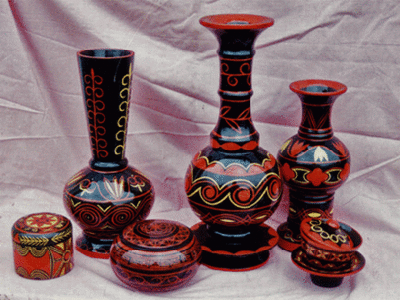Chinese lacquerwares must break through
To deal with the status quo, Chen Biyu was assigned by Fuzhou municipal government to take charge of the management and research and development of arts and crafts. She soon took measures to preserve and develope lacquerwares. Based on the two lacquer factories, Chen first summoned a group of laid-off lacquerware craftsmen and established a lacquerware production assembly for visiting tourists. Before long in 2006, Fuzhou bodiless lacquerware was inscribed on the China Intangible Cultural Heritage List. In 2007, unified standards for lacquerware production were carried out. Now in the base there are showrooms displaying masterpieces made by generations of lacquer masters. Lacquer products are sold at prices raging from hundreds to thousands of RMB.
 |
|
|
The production cycle of bodiless lacquerware is very long and the procedures are very complicated. It demands highly qualified skills. Many layers of lacquering is required and it is best done on cloudy days. As a result workers usually have to work overtime. An experienced worker has to spend one or two months working on a vase of one meter high, earning 3000 Yuan.
An experienced mastered told us: “I used to learn lacquerware making from my teacher but the tradition hindered the improvement of lacquerware because teacher always held back his most consummate skill. Now there are lacquer departments in universities but graduates are unwilling to choose lacquer making as career. It is too suffering. One has to undergo the heat and pungent smell in the dirty workshop and also the allergy to raw lacquer. They can not live with it at all.”
Chen added: “In China handcraft is belittled by both graduates and their parents. However in Japan lacquerware craftsmen are regarded as treasures and traditional crafts are highly respected. I have advocated that the government should support the arts and crafts, in terms of the students’ tuition and its employment after graduation. Right now we provide allowance to our masters who teach students.”
Last year CCTV shot a program in Fuzhou, introducing Fuzhou bodiless lacquerwares, which gained a very good response. A group of collectors came to Fuzhou for lacquerwares, prices rose rapidly. The floursing of an art requires two preconditions: people (the creator) and market (the consumer). Lacquer’s breakthrough, after all is the breaking through of art concept. Now the market can be exploited, new consumers cultivated.
Back to Zero, Set Off Again
There are three ambassadors of Chinese culture: ink painting, porcelain, and lacquerware. To revive lacquer is to renovate the integrity of Chinese culture.
China Academy of Art has another campus in Xiangshan, far removed rom downtown Ningbo City but with a unique environment and architectures. The small space under the grandstand of the football field is the laboratory of lacquer department. “Despite of the shabbiness of the room, this is where the first lacquer major was born.” said Tang Mingxiu, dean of lacquer department of China Academy of Art. To Tang, the year 2005 is the turning point of his artistic life. In 2005 he first held his personal lacquer painting exhibition in Shanghai and then was appointed as the dean of lacquer painting department. “First batch of undergraduate students was only 20 or so. Right now there are 40 undergraduates and 9 graduate students.” said Tang.
A student of Tang’s told us that all the students chose lacquer as their major by themselves. Although at first they knew little about lacquer making and were even seriously allergic to raw lacquer, they still held on. “They learn very fast. I feel relieved on their success and I can see the hope of Chinese lacquer in my students. China is the origin of lacquer, not Japan, despite what the Japanese say. However, the process of lacquer making in China once ceased. This resulted in Chinese people’s ignorance and lack of aesthetic taste for lacquer. That is why I accepted this position, switched my role and start from zero.” Tang Mingxiu also figured out that people who set up their mind to work on art are unnecessarily worrying about employment. Excellent artists live on their works. “My own experience can be a convincing example. For more than 30 years, I have been living with the money from the works I sold. To be frank, now there are many collectors who are interested in our students’ works. But I suggest that they do not enter the market too impulsively. It takes a long time to finish a piece of lacquerware. To do the work well, one need to get rid of the lure of the market.” Ahead there is still a long match for the revival of lacquer. There is no reason for us to be overly optimistic. Furthur development requires a consistent cultural standpoint and attitude.
Make the Lacquerwares Fashionable, Return Lacquerware to Life
Chen Jie majored in lacquer in the 1980s. In 1988, he started his own workshop, pioneering the Fuzhou lacquer market. “I had no idea about the market, I just made lacquerwares. I failed at first and realized the traditions were definitely out of date. The majority of consumers are young people who are eager to see the novelty. There were even people who thought lacquer craft was the same as making coffins.”
Chen Jie began to make his lacquerwares more fashionable, hoping they would be used in daily life rather than being collected on a shelf. With this concept in mind, he developed many new categories of lacquerwares such as furniture, stationery, vases and accessories. He designed many stylish bracelets for girls and his folding screen is sold at 300 thousand RMB. Enterprisers like to put it in their living room.
Art is also a form of commodity and lacquerwares are commodities with deep roots in art.
Lacquer Paintings Exalt the Cultural Taste of Lacquer
The aesthetic taste of an artist determines his cultural ground. Shen Kelong, who has shifted his identity from an oil painter to a lacquer painter, is seeking outlets. He used to be a promising oil painter. Not satisfied with representational art, he successfully extended his art into abstract. Afterward, he became obsessed with lacquer and started to express his abstract ideas through lacquer, from which he discovered deeper Chinese philosophies. However, to change medium for any painter is undoubtedly a high stakes gamble of your artistic identity
In 2007, Shen Kelong, graduated from the sculpture department of Nanjing Art Institute. He did a painting where he painted lacquer on the flax, presenting the impression of ink painting. “Lacquer can diffuse and pile, which is not available on rice paper. Lacquer painting is Chinese oil painting and I can see its infinite possibilities. Showing the lacquer painting to European people will accumulate our advantage and confidence.”
This February, Shen held exhibition in Beijing, all of his 21 pieces of lacquer paintings sold out. His oil paintings were sold at least 100 thousand RMB per piece. It takes more than 10 times longer to complete a lacquer painting so the setting the price of his lacquer painting at 300 thousand RMB were still reasonable.
At present, Shen Kelong works on his lacquer paintings in peace and is not in the least eager to cast his works into the market. “Lacquer paintings have to stand the examination of time. Therefore, I often need to slow down and think about it.”
Lacquer painter Tang Zhiyi also shifted from oil painting. He attaches much importance on the cultivation of students. “Art academies only teach lacquer to students in third and forth grade, I think that is too late. Recently I pointed out that leaning should start from the second year. Students need time to establish an affiliation with lacquer without which they cannot do well at all. Our goal is to cultivate talent that will succeed the traditions as well as talent that will be able to innovate. Only in this way can we move further. Lacquer painting takes a long time. During the process of making and using lacquer appear unexpected changes may happen. That is exactly the attraction of lacquer.”
Translated by Quran
















